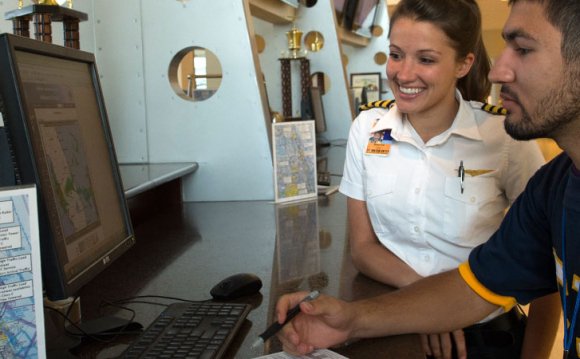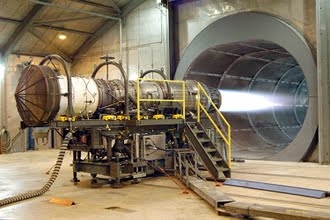
Aeronautics (from the ancient Greek words ὰήρ āēr, which means "air", and ναυτική nautikē which means "navigation", i.e. "navigation of the air") is the science or art involved with the study, design, and manufacturing of air flight capable machines, and the techniques of operating aircraft and rockets within the atmosphere. The British Royal Aeronautical Society identifies the aspects of "aeronautical Art, Science and Engineering" and "the profession of Aeronautics (which expression includes Astronautics)."
While the term—literally meaning "sailing the air"—originally referred solely to the science of operating the aircraft, it has since been expanded to include technology, business and other aspects related to aircraft. The term "aviation" is sometimes used interchangeably with aeronautics, although "aeronautics" includes lighter-than-air craft such as airships, and includes ballistic vehicles while "aviation" technically does not.
A significant part of aeronautical science is a branch of dynamics called aerodynamics, which deals with the motion of air and the way that it interacts with objects in motion, such as an aircraft.
Early ideas[edit]
Designs for flying machines by Leonardo da Vinci, circa 1490
Attempts to fly without any real aeronautical understanding have been made from the earliest times, typically by constructing wings and jumping from a tower with crippling or lethal results.
Wiser investigators sought to gain some rational understanding through the study of bird flight. An early example appears in ancient Egyptian texts. Later medieval Islamic scientists also made such studies. The founders of modern aeronautics, Leonardo da Vinci in the Renaissance and Cayley around 1800, both began their investigations with studies of bird flight.
Man-carrying kites are believed to have been used extensively in ancient China. In 1282 the European explorer Marco Polo described the Chinese techniques then current. The Chinese also constructed small hot air balloons, or lanterns, and rotary-wing toys.
An early European to provide any scientific discussion of flight was Roger Bacon, who described principles of operation for the lighter-than-air balloon and the flapping-wing ornithopter, which he envisaged would be constructed in the future. The lifting medium for his balloon would be an "aether" whose composition he did not know.
In the late fifteenth century, Leonardo da Vinci followed up his study of birds with designs for some of the earliest flying machines, including the flapping-wing ornithopter and the rotating-wing helicopter. Although his designs were rational, they were not based on particularly good science. Many of his designs, such as a four-person screw-type helicopter, have severe flaws. He did at least understand that "An object offers as much resistance to the air as the air does to the object." (Newton would not publish the Third law of motion until 1687.) His analysis led to the realisation that manpower alone was not sufficient for sustained flight, and his later designs included a mechanical power source such as a spring. Da Vinci's work was lost after his death and did not reappear until it had been overtaken by the work of George Cayley.
Balloon flight[edit]
Francesco Lana de Terzi's flying boat concept c.1670
The modern era of lighter-than-air flight began early in the 17th century with Galileo's experiments in which he showed that air has weight. Around 1650 Cyrano de Bergerac wrote some fantasy novels in which he described the principle of ascent using a substance (dew) he supposed to be lighter than air, and descending by releasing a controlled amount of the substance.Francesco Lana de Terzi measured the pressure of air at sea level and in 1670 proposed the first scientifically credible lifting medium in the form of hollow metal spheres from which all the air had been pumped out. These would be lighter than the displaced air and able to lift an airship. His proposed methods of controlling height are still in use today; by carrying ballast which may be dropped overboard to gain height, and by venting the lifting containers to lose height. In practice de Terzi's spheres would have collapsed under air pressure, and further developments had to wait for more practicable lifting gases.
From the mid-18th century the Montgolfier brothers in France began experimenting with balloons. Their balloons were made of paper, and early experiments using steam as the lifting gas were short-lived due to its effect on the paper as it condensed. Mistaking smoke for a kind of steam, they began filling their balloons with hot smoky air which they called "electric smoke" and, despite not fully understanding the principles at work, made some successful launches and in 1783 were invited to give a demonstration to the French Academie des Sciences.
Meanwhile, the discovery of hydrogen led Joseph Black in c. 1780 to propose its use as a lifting gas, though practical demonstration awaited a gastight balloon material. On hearing of the Montgolfier Brothers' invitation, the French Academy member Jacques Charles offered a similar demonstration of a hydrogen balloon. Charles and two craftsmen, the Robert brothers, developed a gastight material of rubberised silk for the envelope. The hydrogen gas was to be generated by chemical reaction during the filling process.
The Montgolfier designs had several shortcomings, not least the need for dry weather and a tendency for sparks from the fire to set light to the paper balloon. The manned design had a gallery around the base of the balloon rather than the hanging basket of the first, unmanned design, which brought the paper closer to the fire. On their free flight, De Rozier and d'Arlandes took buckets of water and sponges to douse these fires as they arose. On the other hand, the manned design of Charles was essentially modern. As a result of these exploits, the hot-air ballon became known as the Montgolfière type and the hydrogen balloon the Charlière.
Charles and the Robert brothers' next balloon, , was a Charlière that followed Jean Baptiste Meusnier's proposals for an elongated dirigible balloon, and was notable for having an outer envelope with the gas contained in a second, inner ballonet. On 19 September 1784, it completed the first flight of over 100 km, between Paris and Beuvry, despite the man-powered propulsive devices proving useless.
In an attempt the next year to provide both endurance and controllability, de Rozier developed a balloon having both hot air and hydrogen gas bags, a design which was soon named after him as the Rozière. The principle was to use the hydrogen section for constant lift and to navigate vertically by heating and allowing to cool the hot air section, in order to catch the most favourable wind at whatever altitude it was blowing. The balloon envelope was made of goldbeaters skin. The first flight ended in disaster and the approach has seldom been used since.
RELATED VIDEO












